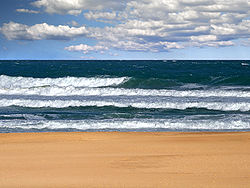Biosphere

The biosphere includes everything living on Earth. It is also known as ecosphere. Currently the biosphere has a biomass (or amount of living things) at around 1900 gigatonnes of carbon. It is not certain exactly how thick the biosphere is, though scientists predict that it is around 12,500 meters. The biosphere extends to the upper areas of the atmosphere, including birds and insects.
In a general sense, biospheres are any closed, self-regulating systems containing ecosystems. This includes artificial biospheres such as Biosphere 2 and BIOS-3, and potentially ones on other planets or moons.[1]
Origin of the term
The word "biosphere" was coined by geologist Eduard Suess in 1875. Which he defined as a place on Earth's surface where life dwells.[2]
Biosphere of the Earth
The earliest known evidence of life in Earth includes biogenic graphite dated as far as 3.7 Billion years old.[3] Life is scattered all throughout the surface of the Earth, from the polar ice caps to the equator, exhibits a life of some kind.
Extents of biological life
Almost all parts of the planet contains a life of some kind. Recent advances in microbiology concluded that microbes can live deep beneath the Earth's surface.
Biosphere Media
A beach scene on Earth, simultaneously showing the lithosphere (ground), hydrosphere (ocean) and atmosphere (air)
Xenophyophore, a barophilic organism, from the Galapagos Rift
References
- ↑ "Meaning of biosphere". WebDictionary.co.uk. Retrieved 2010-11-12.
- ↑ Suess E. (1875). The Origin of the Alps. Vienna.
- ↑ Bell, Elizabeth A.; Boehnike, Patrick; Harrison, T. Mark; et al. (19 October 2015). "Evidence for early life in Earth's oldest hydrothermal vent precipitates" (PDF). Nature. 543 (7643): 60–64. doi:10.1038/nature21377. PMID 28252057. S2CID 2420384.
Other Page
- Biosphere reserve - Project by UNESCO
+{{{1}}}−{{{2}}}




